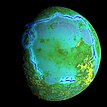Lunar mare

The lunar maria (
The names of maria refer to sea features (Mare Humorum, Mare Imbrium, Mare Insularum, Mare Nubium, Mare Spumans, Mare Undarum, Mare Vaporum, Oceanus Procellarum, Mare Frigoris), sea attributes (Mare Australe, Mare Orientale, Mare Cognitum, Mare Marginis), or states of mind (Mare Crisium, Mare Ingenii, Mare Serenitatis, Mare Tranquillitatis). Mare Humboldtianum and Mare Smythii were established before the final nomenclature, that of states of mind, was accepted, and do not follow this pattern.[3] When Mare Moscoviense was discovered by the Luna 3, and the name was proposed by the Soviet Union, it was only accepted by the International Astronomical Union with the justification that Moscow is a state of mind.[4]
Ages
The ages of the mare basalts have been determined both by direct radiometric dating and by the technique of crater counting. The radiometric ages range from about 3.16 to 4.2 billion years old (Ga),[5] whereas the youngest ages determined from crater counting are about 1.2 Ga.[6] Nevertheless, the majority of mare basalts appear to have erupted between about 3 and 3.5 Ga. The few basaltic eruptions that occurred on the far side are old, whereas the youngest flows are found within Oceanus Procellarum on the nearside. While many of the basalts either erupted within, or flowed into, low-lying impact basins, the largest expanse of volcanic units, Oceanus Procellarum, does not correspond to any known impact basin.
Distribution of basalts
This section needs additional citations for verification. (November 2013) |
There are many common misconceptions concerning the spatial distribution of mare basalts.
- Since many mare basalts fill low-lying impact basins, it was once assumed that the impact event itself somehow caused the volcanic eruption. Note: current data in fact may not preclude this, although the timing and length of mare volcanism in a number of basins cast some doubt on it. Initial mare volcanism generally seems to have begun within 100 million years of basin formation.[7] Although these authors felt that 100 million years was sufficiently long that a correlation between impact and volcanism seemed unlikely, there are problems with this argument.[citation needed] The authors also point out that the oldest and deepest basalts in each basin are likely buried and inaccessible, leading to a sampling bias.
- It is sometimes suggested that the gravity field of the Earth might preferentially allow eruptions to occur on the centrifugal accelerationthe Moon is experiencing is exactly equal and opposite to the gravitational acceleration of the Earth. There is thus no net force directed towards the Earth. The Earth tides do act to deform the shape of the Moon, but this shape is that of an elongated ellipsoid with high points at both the sub- and anti-Earth points. As an analogy, there are two high tides per day on Earth, and not one.
- Since mare basaltic magmas are denser than upper crustal anorthositic materials, basaltic eruptions might be favored at locations of low elevation where the crust is thin. However, the far side South Pole–Aitken basin contains the lowest elevations of the Moon and yet is only sparingly filled by basaltic lavas. In addition, the crustal thickness beneath this basin is predicted to be much smaller than beneath Oceanus Procellarum. While the thickness of the crust might modulate the quantity of basaltic lavas that ultimately reach the surface, crustal thickness by itself cannot be the sole factor controlling the distribution of mare basalts.[8]
- It is commonly suggested that there is some form of link between the spherical harmonic degree-2 terms of the gravity field), and the mare basalts hardly contribute to this (see also tidal locking). (Hemispheric structures correspond to spherical harmonic degree 1, and do not contribute to the moments of inertia.) Furthermore, tidal despinning is predicted to have occurred quickly (in the order of thousands of years), whereas the majority of mare basalts erupted about one billion years later.

The reason that the mare basalts are predominantly located on the near-side hemisphere of the Moon is still being debated by the scientific community. Based on data obtained from the
Chemical composition
Using terrestrial classification schemes, all mare basalts are classified as
See also
- Apollo 11 landing site
- Volcanism on the Moon
- List of maria on the Moon
- Moon
- Moon rabbit
- Moon rock
- Selenography
References
- ^ "mare". Lexico UK English Dictionary. Oxford University Press. Archived from the original on 2022-06-29. Retrieved 2022-09-02.
Classical pronunciation is sg. /ˈmɛəri/. - ^ Apuleius, Metamorphoses 1.3
- ^ "XIth General Assembly" (PDF) (in French and English). International Astronomical Union. 1961. Retrieved 26 July 2015.
- PMID 22914129.
- ^ James Papike; Grahm Ryder; Charles Shearer (1998). "Lunar Samples". Reviews in Mineralogy and Geochemistry. 36: 5.1–5.234.
- S2CID 9570915.
- S2CID 127501718.
- .
- S2CID 130734866.
- ^ G. Jeffrey Taylor (August 31, 2000). "A New Moon for the Twenty-First Century". Planetary Science Research Discoveries.
- .
- .
Further reading
- Paul D. Spudis, The Once and Future Moon, Smithsonian Institution Press, 1996, ISBN 1-56098-634-4.
- G. Jeffrey Taylor (April 30, 2006). "Finding Basalt Chips from Distant Maria". Planetary Science Research Discoveries.
- G. Jeffrey Taylor (December 5, 2000). "Recipe for High-Titanium Lunar Magmas". Planetary Science Research Discoveries.
- G. Jeffrey Taylor (June 23, 2000). "The Surprising Lunar Maria". Planetary Science Research Discoveries.
- Catherine Weitz (February 12, 1997). "Explosive Volcanic Eruptions on the Moon". Planetary Science Research Discoveries.



